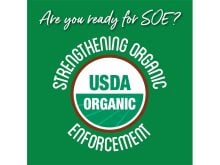Looking for the best place to make a stink could soon become easier.
A committee representing the hog industry, federal, provincial and academic experts is putting together a set of maps to highlight ideal spots for hog development across the Prairies.
The maps won’t dictate where new barns have to be built, said Loraine Bailey a committee member representing Agriculture Canada’s Brandon Research Centre.
Instead, they offer producers, investors and provincial and municipal governments a color-coded gauge to help manage risk in each region across the Prairies.
Read Also

U.S. bill could keep out Canadian truckers
The Protecting America’s Roads Act, which was tabled in the U.S. House of Representatives at the beginning of October, would “rid the country of illegal immigrant commercial truck drivers and ineligible foreign nationals.”
“We have no time to waste in getting technological information to producers,” said Bailey, co-ordinator of the Hog Manure Environmental Management Strategy, also known as HEMS.
“It was needed yesterday.”
Bailey said the federal government wants the committee to identify gaps in hog manure management. By fixing those problems the industry can be helped economically and environmentally.
In charge of the western provinces, Bailey said the group is looking at how to fill manure management gaps by bringing in new technology from other countries, or by putting more resources into research.
One of the group’s first meetings in Saskatoon in February targeted manure management mapping as a top priority.
“Different soils have different characteristics and different abilities to hold moisture,” he said.
“We’re not saying to producers this is what you have to abide by,” he said, adding the maps will act as location-specific nutrient management strategies.
Using GIS, or global information systems, the maps will identify soil properties across the Prairies including hydrological characteristics, landscape, soil type, depth of the ground water table and nutrient absorbing capabilities.
“This is not showing soils that are a dumping ground for manure. This is nutrient management,” Bailey said.
A producer thinking about raising hogs could take the map, pinpoint the location and find out if it is a high or low risk area through color codes.
If it is a red, or high-risk area, the producer can use overlays describing options that would lower the risk.
“Say maybe if you have a pasture in a red area and use hog manure on the pasture, all of a sudden my risk reduces and changes color,” Bailey said.
He predicted soon governments will step in with regulations and producers won’t have a choice on how they manage manure.
South of the border, the United States Department of Agriculture and the Environmental Protection Agency are moving toward laws that would require all producers to submit nutrient management plans for their farms, he said.
“It is state law in some places now, but they’re moving toward making it federal law and once that happens, we’re next,” Bailey said.
“We can’t get away with it because of our NAFTA (North American Free Trade Agreement) with the U.S.”
Environmental issues the committee is pondering include odor, soil and water quality and air emissions, or ammonia particulates resulting from nitrogen use.
Bailey said provincial maps should be ready in a year, but the committee plans to issue them to municipalities.
Then, it will be up to local governments to choose how to use the maps to help locate hog barns.
Brandon Economic Development Board general manager Don Allan said manure mapping could be one way to control the public debate and controversy over hog barn applications.
Opposition to barns has been overstated, he told business leaders at a meeting in Brandon last month.
“The number of hog barns actually turned down, you could count on one hand. You hear a lot about it in the papers but they just end up going somewhere else,” Allan said.
“Around 30 or 40 have been approved but you don’t hear much about that.”
With the expected expansion of the industry prompted by Maple Leaf’s decision to build a $112 million hog processing plant in the city, Allan said Brandon hopes to address problems before they happen.
“There are a lot of nightmares out there in other jurisdictions. We like to think if we’re aware of those problems up front that we can mitigate them up front.”
















